My Cart(0)
Tiny Hands, Big Conversations: The Power of Baby Sign Language

Introduction
The journey into parenthood is a fascinating adventure filled with joy, wonder, and the constant quest to understand and communicate with your little one. While babies might not be able to verbally express themselves, they are incredibly receptive to non-verbal cues. In recent years, baby sign language has emerged as a powerful tool to bridge the communication gap between parents and their pre-verbal infants. In this blog post, we'll explore the benefits of teaching your baby sign language, practical tips on how to get started, and insights from experts in the field.

Understanding the Basics of Baby Sign Language
Baby sign language involves using simple gestures or signs to communicate with infants before they can speak. Contrary to common misconceptions, introducing sign language to your baby does not hinder speech development; instead, it complements it. According to a comprehensive guide on The Bump, exposing your baby to sign language can enhance early communication skills, reduce frustration, and strengthen the parent-child bond.
-
Communication Before Words: A Revolutionary Approach
The traditional belief is that babies start communicating only when they utter their first words. However, experts from the University of Utah, as cited in a post on Healthcare.utah.edu, propose a revolutionary idea: babies can start communicating long before they speak. The article discusses how babies naturally communicate through gestures, pointing, and facial expressions. By introducing sign language, parents can tap into this innate ability and provide babies with a means to express themselves earlier than through spoken language.
-
Reducing Frustration and Tears
One of the primary challenges parents face is deciphering their baby's needs and wants, especially before they can articulate them verbally. The What to Expect article emphasizes that teaching your baby sign language can be a game-changer in this aspect. By giving your baby a set of simple signs for common needs like hunger, tiredness, or discomfort, you can significantly reduce frustration on both sides. This can lead to a more harmonious parent-child relationship and a happier household.
Practical Tips for Teaching Baby Sign Language
Now that we understand the benefits, let's delve into the practicalities of introducing sign language to your little one.
-
Start Simple and Relevant
The Bump recommends beginning with basic signs that are relevant to your baby's daily life. Signs for "milk," "more," "eat," and "all done" are excellent starting points. These signs directly relate to your baby's immediate needs, making it more likely for them to catch on quickly.
-
Consistency is Key
Consistency is crucial when teaching baby sign language. Repeat the signs regularly, especially in situations where the sign is contextually relevant. Repetition helps reinforce the connection between the sign and its meaning in your baby's mind.
-
Incorporate Signs into Daily Routines
Integrate signs into your daily routines. During mealtime, use signs for "eat" and "drink." Before bedtime, incorporate signs for "sleep" or "night-night." The more consistently you use signs in context, the more likely your baby is to pick them up.
-
Make it Fun and Interactive
Learning should be an enjoyable experience for your baby. Use animated facial expressions, engage in eye contact, and celebrate when your baby successfully mimics a sign. The more positive reinforcement your baby receives, the more motivated they will be to continue learning.
Addressing Concerns and Misconceptions
Despite the growing popularity of baby sign language, there are still concerns and misconceptions that need addressing.
-
Speech Development Concerns
One common worry is that introducing sign language might hinder a baby's speech development. However, as mentioned in the What to Expect article, research indicates that the opposite is true. Babies exposed to sign language often start speaking earlier and have a broader vocabulary.
-
Age Considerations
Some parents might wonder if it's too late to start if their baby is past a certain age. According to Healthcare.utah.edu, the ideal time to start is around 6 to 9 months, but you can introduce signs at any age. It's never too late to start fostering better communication with your child.

Conclusion: Opening a World of Communication
In conclusion, baby sign language is a powerful tool that can transform the early parent-child communication dynamic. It opens a window into your baby's world before they can articulate their thoughts verbally, reducing frustration and enhancing the joy of parenting. By starting with simple, relevant signs, being consistent, and making the learning process enjoyable, you can create a meaningful bridge between you and your little one.
So, go ahead, embrace the tiny hands and big conversations that baby sign language can bring into your life. It's not just about gestures; it's about opening up a world of understanding, connection, and shared moments with your precious bundle of joy.
unsubscribe at any time without costs.










